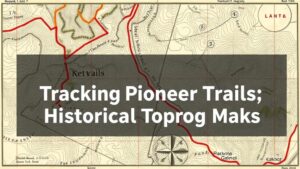Mining Disused Stagecoach Route Maps for Frontier Relic Discoveries
Mining Disused Stagecoach Route Maps for Frontier Relic Discoveries
The study of disused stagecoach routes offers a rich repository of historical and cultural insights, particularly in understanding the development of the American frontier. With many of these routes mapped throughout the 19th century, researchers are increasingly turning to these documents as tools for uncovering relics and artifacts from a pivotal era in American history. This article examines the significance of mining these historical maps to facilitate discoveries related to frontier life, commerce, and migration patterns in the western United States.
Historical Context of Stagecoach Routes
Stagecoach routes emerged as vital transportation channels during the 1800s, particularly after the establishment of the Pony Express in 1860 and the expansion of the Overland Mail Company. e routes connected burgeoning towns and facilitated not just travel, but also the movement of goods and services across vast distances.
For example, the Hastings Cutoff, which was used during the ill-fated Donner Party expedition in 1846, exemplifies the complexities and dangers associated with these routes. Utilizing historical maps from this period allows researchers to trace these pathways and their impacts on migration and settlement patterns.
Mapping Techniques and Technologies
Modern methodologies for analyzing stagecoach maps have evolved significantly with advancements in technology. Geographic Information Systems (GIS) have become invaluable tools for historians and archaeologists. By digitizing and overlaying historical maps onto current geographic data, scholars can identify potential relic sites that were accessible via these routes.
For example, researchers can utilize satellite imagery in conjunction with GPS technology to locate remnants of station stops where travelers once rested, such as the historic Hollenberg Pony Express Station in Kansas, built in 1858.
Identifying Relics and Artifacts
As scholars study these maps, they can direct excavation efforts toward areas where stagecoach routes intersected with settlements, Native American trails, and mining locations. This multi-layered approach increases the likelihood of uncovering significant artifacts.
- Coins and personal items left by travelers
- Tools and technology from the period, such as harnesses and wagon wheels
- Trade goods exchanged between cultures
According to a 2021 study from the American Antiquity journal, archaeological findings along the McKenzie River trail in Oregon revealed a trove of items that offered insights into trade dynamics and daily life during the mid-1800s. These discoveries underscore the importance of using historic maps as a guide to inform excavation practices.
Challenges in Researching Stagecoach Routes
Despite the wealth of information available, researchers face several challenges when utilizing stagecoach maps for relic discoveries. One significant issue is the degradation of these historical documents over time. Many maps have deteriorated due to environmental factors, making them difficult to read. Misinterpretations can lead to misguided excavations, wasting valuable resources.
Also, there are often conflicting accounts of routes, as various stagecoach companies operated in the same regions, each with their own maps that may not align with one another. As noted by historian Robert E. Wood in Stagecoach Travel: A Brief History, scholars must cross-reference multiple sources to ascertain the most accurate routes.
Real-World Applications of Research Findings
The findings derived from studying disused stagecoach routes have profound implications not only for archaeological practices but also for local tourism and education. By uncovering historical relics, communities can construct heritage trails or museums that celebrate their local history, thus fostering educational opportunities and promoting cultural awareness.
An illustrative example can be found in California’s Gold Country, where historical mining towns have leveraged discoveries linked to stagecoach routes to attract visitors. Events, such as re-enactments and guided historical tours, provide context and engage the public, fostering a renewed interest in local history.
Actionable Takeaways for Researchers
- Employ GIS technology to analyze historical maps more effectively.
- Collaborate with archaeologists to develop comprehensive excavation plans.
- Engage in public history initiatives to raise awareness and support for local heritage projects.
To wrap up, mining disused stagecoach route maps is a crucial endeavor for understanding and preserving the history of the American frontier. By adopting modern research methodologies and collaborative strategies, scholars can enhance their discoveries and foster greater appreciation for this significant aspect of American history.


